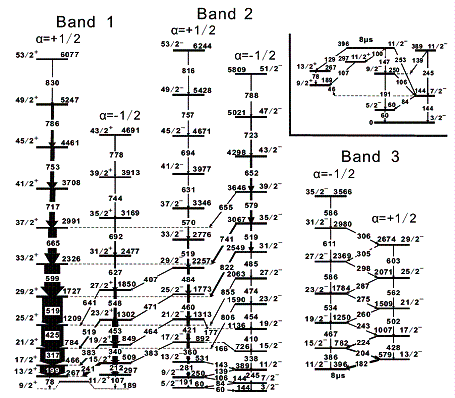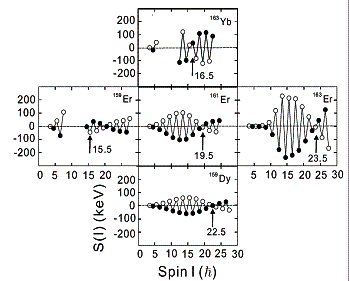Researchers in Institute of Modern Physics , Chinese Academy of Sciences(IMP)succeeded in studying high-spin states in 161Er using the Joined in Beam Gamma Equipment of the HI-13MV Tandem Accelerator Laboratory at China Institute of Atomic Energy.
High-spin states in 161Er were produced experimentally using the 150Nd(16O, 5n) heavy-ion fusion-evaporation reaction at a beam energy of 86 MeV. X-γ-t and γ-γ-t coincidence measurements were performed with a detector array, which consisted of nine HPGe detectors with BGO anti-Compton shields, two low-energy planar Ge detectors, and one Clover detector. Based on the measurements, the rotational bands in 161Er are extended up to high-spin states, and particularly the α=-1/2 branch of the ground state band is revised significantly. Nine relatively enhanced E1 transitions connecting the bands with opposite parities are observed. A new level scheme for 161Er is presented in Fig. 1.
As shown in Fig. 2, signature inversion occurs in band 2 after the band crossing in 161Er. The systematics of the signature inversions associated with the 3/2-[521] configuration are discussed. It should be noted that the spin value of inversion point shows a very regular pattern while changing the proton and neutron numbers. By systematically analyzing the properties of the relatively enhanced E1 transitions between the 3/2-[521] and 5/2+[642] bands in the N=93 isotones, it is found that the R(E1) values show angular momentum dependence before the band crossing. The enhanced E1 transitions could be attributed to octupole softness.
The band properties are analyzed within the framework of a triaxial particle-rotor model. The level energy and large signature splitting in band 1 and band 2 can be well reproduced by the PRM calculation if assuming a near-prolate deformation and triaxial deformation for band 1 and band 2, respectively.
The results were published in Physical Review C 83, 034318 (2011).

Fig.1 Level scheme of 161Er deduced from the present work.(Image by IMP)

Fig. 2 Compilation of signature inversion for the 3/2−[521] bands in 161,163,165Er, 159Dy, and 159Yb.(Image by IMP)

